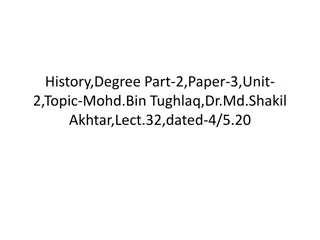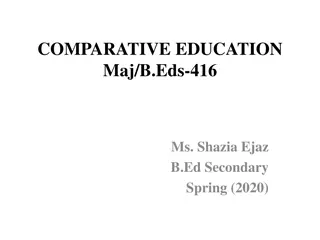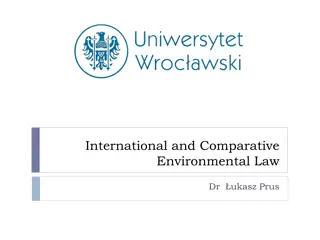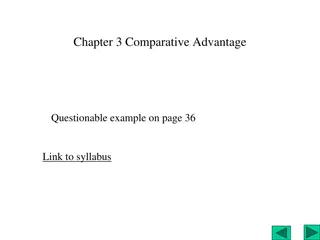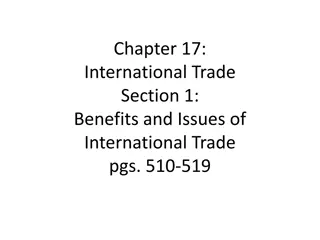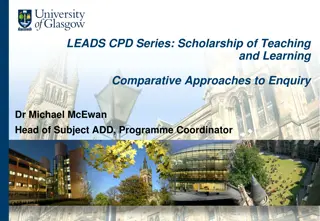Comparative Study of Planning in Jech, Rechna, and Bari Doab
The article discusses the planning and development principles in JECH, RECHNA, and BARI DOAB regions in Pakistan. It highlights the historical background, canal development, chakbandi system, well-planned villages, market towns, and impact of transportation on trade and commerce. The JECH DOAB region, situated between the Jhelum and Chenab rivers, showcases colonized landscapes and chaks. In contrast, the RECHNA DOAB region, between the Chenab river and its major canals, features planned towns like Lyallpur and Jaranwala. The article also touches upon planned and unplanned areas, such as Bet lands prone to flooding.
Download Presentation

Please find below an Image/Link to download the presentation.
The content on the website is provided AS IS for your information and personal use only. It may not be sold, licensed, or shared on other websites without obtaining consent from the author. Download presentation by click this link. If you encounter any issues during the download, it is possible that the publisher has removed the file from their server.
E N D
Presentation Transcript
LECTURE # 05 COMPARATIVE STUDY OF PLANNING IN JECH, RECHNA AND BARI DOAB
JECH DOAB The area between river Jhelum and Chenab is called JECH doab. After the development of main canals ,lower Jhelum from Rasul and further subdivided canals into Shahpur branch ,north and south branches the rural landscapes or these canals and their branches were colonized into chakbandi system and well planned villages called chaks. The market towns also represent the salient features of planning and development principles and practice by the British planners with the help of local knowledge and ground realities of the rural and urban communities
PLANNING OF BAR SUB REGION IN JECH DOAB Sargodha town once it was a planned market town. In the present era it has expanded into a large town and further into a city of upper Punjab in Pakistan . The vast surrounding rural areas of this city consists of hundreds of chaks . This whole area, the city and its vast rural areas is subject to City and Regional planning as the vast rural areas represent regional characteristics.
Cont.. In addition to the city and towns enclaved in the respective part or part of the district Shahpur alone or other district may be a part of Jhang district in its southern periphery. Thus the vast land of Sargodha city and its district and beyond has been delineated as Planned Area which can be discussed in the light of impact of transportation on trade and commerce in such planned areas in the Bar Sub Region.
Cont.. The rest on both sides along rivers represent unplanned villages and other old settlements Many of which suffer from river floods catchment areas- subject to bet land facing flood disaster as the physical and climatic features in monsoon season in general but heavy damages after heavy rain of flood once or twice in a decade. Such areas in broader spectrum may be referred as Bet lands which are contrasting in planning and development features as compared to Bar land.
RECHNA DOAB The area between river Chenab and its major canal lower Chenab extracted from KhanKi and upper Chenab from Marala is called RECHNA Doab . After the development of main canals, further Jhang, Rakh and Gogera branches were extracted where major towns notably Lyallpur, Jaranwala and Sheikhupura were planned and developed along the core and peripheral styles in the city and regional areas as already delineated and discussed m the JECH Doab cases.
PLANNING OF BAR SUB REGION IN RECHNA DOAB The vast rural areas on these canals and their sub branches were colonized into chakbandi planned system, with the outcome of well planned villages called chaks and market towns on.that time by the orders of the British government. Bar and Bet areas including cities towns and regions in their respective district or defined large regions.
Cont.. For example Lyallpur town once it was a planned market town. In the present era it has expanded towards its eight direction into a large city of central Punjab . The vast surrounding rural areas of this city consists of many hundreds of planned villages the chaks. This whole area the city and its rural areas are subject to City and Regional Planning areas.
Cont.. Regarding rest of-the land on both 'sides along Chenab and Ravi represent unplanned villages and other settlements and many of which face flood disasters due to the physical-and climatic feature in monsoon season. rivers Such areas in large perspectives may be associated Bet lands which are different in characteristics as compared to the planned catchment areas now called the Bar land with planned villages and now towns where marketing intelligence seems better than in the markets of Bet land . planning and development
BARI DOAB The area between river.Ravi and. its major canal Lower Bari doab' extracted from Balloki and upper Bari doab canal from north is called as, "BARI Doab."
PLANNING OF BAR SUB REGION IN BARI DOAB After the development of main canals from Ferozepur, Sulemanki and Islam and further various tributaries adjacent the river Sutlej have generated a vast planned upland-the Bar land called as "Gangi Bar.". Thus this vast rural areas on these canals and their sub branches were colonized into Chakbandi planned system, with various planned villages and Mandi towns.
Cont.. Chichawatni is the best example of its planned market where production, surplus in storages and marketing intelligence of men and women reflected prosperous situation. Perhaps the market represent strong horizontal and vertical marketing and trade linkages. It has also been noted that the population and density of Montgomery and other districts have also been expanded and increased many times during 1901 to 1972
ASPECTS OF TRADE AND COMMERCE IN BAR AND BET LAND The general local knowledge and comparison of planned the Bar land and unplanned the Bet land has provided the view that high densities were attained in the planned areas and obviously with more and high level of commodity and money. These flows were mainly based on better transport network and canal irrigated productive areas and more over with market towns having planned local, agriculture grain and vegetable markets .
Cont.. Various bradries and castes of zamindars and their cultivators have reported that more than half of their important irrigation water from canals is wasted on ground before reaching to the agriculture land otherwise there would have been many fold production and huge amount of surplus outputs could be highly traded within the country and particularly abroad. The people of Bar lands in various doabs could be prosperous on the land run and their living environment and standards would be improved and sustained .
Cont.. It has also been read in the newspaper observed by the local during last many decades that in the monsoon seasons the human settlements in the Bet land the riverside catchment areas are highly damaged with the losses of human and animal lives with great disasters to a lot of lifeline infrastructure notably physical and social infrastructure in the flood zones . It also indicated that the production by the tube wells in the Bet land in particular have also not served the purpose to uplift the trade and commerce prosperous or parallel to the standards in the Bar land .
Cont.. The income of the farmers in the Bar land show better than in the income levels of the farmers in the Bet land because of deficient links and linkages between their unplanned villages, town and cities in the vast areas of the Bet land . This also clarifies perhaps the planned schools by the British planners in the chakbandi system of chaks and Mandi towns in the Bar land have been upgraded and helped to improve better education ,employments and better living . From trade and commerce of agriculture produce notably Basmati rice and vegetable were subject to more by the women from Bar land than the women from the rest of the Bet land .
Cont.. Thus rice marketing by women at domestic and small scales were notes better from chaks of Bar land as compared to villages Mauzas of Bet land towards the cities mainly due to strong transport linkages by roads and railway to some neighborhood of the respective commercial centers . cities and some
Cont.. Various people of Bar Land have migrated to the nearby or far small ,medium and large cities their employment destinies and they are sending remittance to their origins with the outcome of improvements in their household incomes and their living structures and prosperity .
CONCLUSION In Punjab significant changes were brought by British with their protective and productive policies. The planned Bar region became prosperous with strong transportation linkages international trade and commerce activities. for internal and Based on revolutionary changes in the land uses of planned Bar lands the trade and commerce flourished as indicted by mass agricultural production and export to other countries









